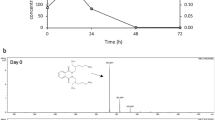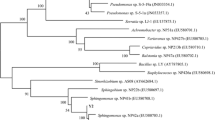Abstract
Phthalic acid esters (PAEs) contamination in water, air, and soil is one of the major environmental concerns in many countries. Besides the PAE biodegradation process, the PAE degrading bacteria have become one of the focuses of study. This study reports the successful isolation of one kind of indigenous bacterium PA-02 from phthalic acid (PA)-degrading aerobic granules. Based on its 16S ribosomal DNA sequence, isolate PA-02 was identified as Sphingomonas genus with 100% similarity to Sphingomonas sp. strain D84532. Strain PA-02 was a Gram-negative, rod-shaped bacterium with strong auto-aggregation ability. In particular, the strain PA-02 possessed PAE-degrading ability without acclimation. Results of growth tests showed that strain PA-02 could degrade dimethyl phthalate (DMP), dibutyl phthalate, and diethylhexyl phthalate. The specific degradation rates of DMP and PA were concentration-dependent with maximum values of 0.4 g-DMP g−1 biomass h−1 and 1.3 g-PA g−1 biomass h−1, respectively. Kinetic studies also revealed that PA-02 was robust under high concentrations of DMP and PA. Even when the PA concentration was increased to 1,000.0 mg l−1, the specific PA degradation rate was about 0.25 g-PA g−1 biomass h−1. The corresponding value for DMP was 0.067 g-DMP g−1 biomass h−1 at 1,000 mg l−1.



Similar content being viewed by others

References
Bauer MJ, Herrmann R (1997) Estimation of the environmental contamination by phthalic acid esters leaching from household wastes. Sci Total Environ 208:49–57
Boone DR, Brenner DJ, Krieg NR, Staley JT (2005) Bergey’s manual of systematic bacteriology, 2nd edn, vol 2. Springer, East Lansing, USA
Bramucci M, Singh M, Nagarajan V (2002) Biotransformation of p-xylene and 2,6-dimethylnaphthalene by xylene monooxygenase cloned from a Sphingomonas isolate. Appl Environ Microbiol 59:679–684
Chang BV, Yang CM, Cheng CH, Yuan SY (2004) Biodegradation of phthalate esters by two bacteria strains. Chemosphere 55:533–538
Chatterjee S, Dutta TK (2003) Metabolism of butyl benzyl phthalate by Gordonia sp. strain MTCC 4818. Biochem Biophys Res Commun 309:36–43
Chen JA, Li X, Li J, Cao J, Qiu ZQ, Zhao Q, Xu C, Shu WQ (2007) Degradation of environmental endocrine disruptor di-2-ethylhexyl phthalate by a newly discovered bacterium, Microbacterium sp strain CQ0110Y. Appl Microbiol Biotechnol 74:676–682
Colon I, Caro D, Bourdony CJ, Rosario O (2000) Identification of phthalate esters in the serum of young Puerto Rican girls with premature breast development. Environ Health Perspect 108:895–900
Fan YZ, Cheng SP, Gu JD (2001) Degradation of phthalic acid and dimethyl phthalate ester by enrichment cultures of aerobic bacteria. Paper presented at the Conference proceedings of IWA Asia Environmental Technology 2001. Singapore, pp 547–554
Ivanov V, Wang XH, Tay STL, Tay JH (2006) Bioaugmentation and enhanced formation of microbial granules used in aerobic wastewater treatment. Appl Microbiol Biotechnol 70:374–381
Jiang HL, Tay JH, Maszenan AM, Tay STL (2004) Bacterial diversity and function of aerobic granules engineered in a sequencing batch reactor for phenol degradation. Appl Environ Microbiol 70:6767–6775
Kleerebezem R, Pol LWH, Lettinga G (1999) Anaerobic degradation of phthalate isomers by methanogenic consortia. Appl Environ Microbiol 65:1152–1160
Knudsen FR, Pottinger TG (1999) Interaction of endocrine disrupting chemicals, singly and in combination, with estrogen-, androgen-, and corticosteroid-binding sites in rainbow trout (Oncorhynchus mykiss). Aquat Toxicol 44:159–170
Lane DJ (1991) 16S/23S rRNA sequencing. In: Goodfellow ESM (ed) Nucleic acid techniques in bacterial systematics. Wiley, Chichester, England, pp 115–175
Leys NM, Ryngaert A, Bastiaens L, Top EM, Verstraete W, Springael D (2005) Culture independent detection of Sphingomonas sp EPA 505 related strains in soils contaminated with polycyclic aromatic hydrocarbons (PAHs). Microb Ecol 49:443–450
Liang DW, Zhang T, Fang HHP (2007) Denitrifying degradation of dimethyl phthalate. Appl Microbiol Biotechnol 74:221–229
Liu YS, Zhang J, Zhang ZZ (2004) Isolation and characterization of polycyclic aromatic hydrocarbons-degrading Sphingomonas sp. strain ZL5. Biodegradation 15:205–212
Marttinen SK, Kettunen RH, Sormunen KM, Rintala JA (2003) Removal of bis(2-ethylhexyl) phthalate at a sewage treatment plant. Water Res 37:1385–1393
Miyachi N, Tanaka T, Suzuki T, Hotta Y, Oori T (1993) Microbial oxidation of dimethylnaphthalene isomers. Appl Environ Microbiol 59:1504–1506
Neefs JM, Vandepeer Y, Hendriks L, Wachter R (1990) Compilation of small ribosomal-subunit RNA sequences. Nucleic Acids Res 18:2237–2317
Nielsen E, Larsen PB (1996) Toxicological evaluation and limit values for DEHP and phthalates other than DEHP. Danish Environmental Protection Agency
Nishio E, Yoshikawa H, Wakayama M, Tamura H, Morita S, Tomita Y (2005) Isolation and identification of Sphingomonas sp. that yields tert-octylphenol monoethoxylate under aerobic conditions. Biosci Biotechnol Biochem 69:1226–1231
Nomura Y, Takada N, Oshima Y (1989) Isolation and identification of phthalate-utilization bacteria. J Ferment Bioeng 67:297–299
Nomura Y, Nakagawa M, Ogawa N, Harashima S, Oshima Y (1992) Genes in PHT plasmid encoding the initial degradation pathway of phthalate in Pseudomonas-putida. J Ferment Bioeng 74:333–344
Ono K, Nozaki M, Hayaishi O (1970) Purification and some properties of protocatechuate 4,5-dioxgenase. Biochim Biophys Acta 220:224–238
Parker WJ, Monteith HD, Melcer H (1994) Estimation of anaerobic biodegradation rates for toxic organic compounds in municipal sludge digestion. Water Res 28:1779–1789
Petrovilc M, Eljarrat E, Liopez MJ, Barcelio D (2001) Analysis and environmental levels of endocrine-disrupting compounds in freshwater sediments. TRAC-Trends Anal Chem 20:637–648
Roslev P, Vorkamp K, Aarup J, Frederiksen K, Nielsen PH (2007) Degradation of phthalate esters in an activated sludge wastewater treatment plant. Water Res 41:969–976
Sasaki M, Maki J, Oshiman K, Matsumura Y, Tsuchido T (2005) Biodegradation of bisphenol A by cells and cell lysate from Sphingomonas sp. strain AO1. Biodegradation 16:449–459
Scholz N, Diefenbach R, Rademacher I, Linneman D (1997) Biodegradation of DEHP, DBP, and DINP: poorly water soluble and widely used phthalate plasticizers. Bull Environ Contam Toxicol 58:527–534
Shelton DR, Boyd SA, Tiedje JM (1984) Anaerobic biodegradation of phthalic acid esters in sludge. Environ Sci Technol 18:93–97
Smibert RM, Krieg NR (1994) Phenotypic characterization. In: Gerhardt P, Murray RGE, Wood WA, Krieg NR (eds) Methods for general and molecular bacteriology. American Society for Microbiology, Washington, DC, pp 607–654
Staples CA, Peterson DR, Parkerton TF, Adams WJ (1997) The environmental fate of phthalate esters: a literature review. Chemosphere 35:667–749
Takeuchi M, Sawada H, Oyaizu H, Yokota A (1994) Phylogenetic evidence for Sphingomonas and Rhizomonas as nonphotosynthetic members of the alpha-4 subclass of the Proteobacteria. Int J Syst Bacteriol 44:308–314
Tay STL, Hemond HF, Polz MF, Cavanaugh CM, Dejesus I, Krumholz LR (1998) Two new Mycobacterium strains and their role in toluene degradation in a contaminated stream. Appl Environ Microbiol 64:1715–1720
Tay STL, Ivanov V, Yi S, Zhuang WQ, Tay JH (2002) Presence of anaerobic bacteroides in aerobically grown microbial granules. Microb Ecol 44:278–285
Tay STL, Jiang HL, Tay JH (2004) Functional analysis of microbial community in phenol-degrading aerobic granules cultivated in SBR. Water Sci Technol 50:229–234
US EPA (1992 and update) Code of federal regulations, 40 CFR, Part 136
Vamsee-Krishna C, Mohan Y, Phale PS (2006) Biodegradation of phthalate isomers by Pseudomonas aeruginosa PP4, Pseudomonas sp PPD and Acinetobacter lwoffii ISP4. Appl Microbiol Biotechnol 72:1263–1269
Vega D, Bastide J (2003) Dimethylphthalate hydrolysis by specific microbial esterase. Chemosphere 51:663–668
Wang JL, Liu P, Qian Y (1995) Microbial degradation of di-n-butyl phthalate. Chemosphere 31:4051–4056
Wang JL, Liu P, Qian Y (1997) Biodegradation of phthalic acid esters by immobilized microbial cells. Environ Int 23:775–782
Wang JL, Liu P, Shi HC, Qian Y (1998) Kinetics of biodegradation of di-n-butyl phthalate in continuous culture system. Chemosphere 37:257–264
Wang YY, Fan YZ, Gu JD (2003) Aerobic degradation of phthalic acid by Comamonas acidovoran Fy-1 and dimethyl phthalate ester by two reconstituted consortia from sewage sludge at high concentrations. World J Microbiol Biotechnol 19:811–815
Yurkov V, Stackebrandt E, Buss O, Vermeglio A, Gorlenko V, Beatty JT (1997) Reorganization of the genus Erythromicrobium: description of “Erythromicrobium sibiricum” as Sandaracinobacter sibiricus gen. nov., sp. nov., and of “Erythromicrobium ursincola” as Erythromonas ursincola gen. nov., sp. nov. Int J Syst Bacteriol 47:1172–1178
Zeng F, Cui KY, Li XD, Fu JM, Sheng GY (2004) Biodegradation kinetics of phthalate esters by Pseudomonas fluoresences FS1. Process Biochem 39:1125–1129
Zhang G, Peardon KF (1990) Parametric study of diethyl phthalate biodegradation. Biotechnol Lett 12:699–704
Ziogou K, Kirk PWW, Lester JN (1989) Behavior of phthalic-acid esters during batch anaerobic-digestion of sludge. Water Res 23:743–748
Acknowledgment
We thank Mr. C.L. Cheah for correcting the language.
Author information
Authors and Affiliations
Corresponding author
Rights and permissions
About this article
Cite this article
Zeng, P., Moy, B.YP., Song, YH. et al. Biodegradation of dimethyl phthalate by Sphingomonas sp. isolated from phthalic-acid-degrading aerobic granules. Appl Microbiol Biotechnol 80, 899–905 (2008). https://doi.org/10.1007/s00253-008-1632-x
Received:
Revised:
Accepted:
Published:
Issue Date:
DOI: https://doi.org/10.1007/s00253-008-1632-x



